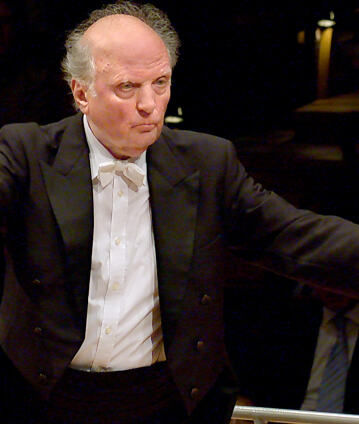Marek Janowski conducts Bruckner’s Fourth Symphony

Marek Janowski is regarded as the perfect embodiment of the kapellmeister tradition and a master of late-Romantic repertoire, and this programme with Bruckner’s Fourth Symphony and preludes from Pfitzner’s Palestrina emphasizes these qualities. The special charm of both works is the way they look to the past: Pfitzner evokes the world of the Renaissance, while Bruckner immerses himself in a medieval age full of knights and sounds of the forest.
When Marek Janowski, at the end of December 2016, gave his final two concerts in his capacity as chief conductor of the Rundfunk-Sinfonieorchester Berlin in the Konzerthaus at the Gendarmenmarkt, the audiences had mixed emotions: sadness, because it meant saying goodbye for the moment to a conductor who had repeatedly provided the musical life of the capital with striking highlights during his 14-year tenure in Berlin; and happiness, because the Berliners knew that Janowski would continue to remain loyal to them – including, of course, as a guest conductor with the Berliner Philharmoniker with whom he has had artistic ties since 1976. In addition to the three orchestral preludes from Hans Pfitzner’s opera Palestrina, a work premiered in 1917 and totally committed to the late Romantic idiom, Janowski has programmed one of Anton Bruckner’s most popular symphonies, his Fourth, which was composed in 1874 and which by 1880 had undergone multiple revisions.
Bruckner himself once called the Fourth the “most understandable” of his works, but he also tried to describe their music by linguistic means. For example, Bruckner once noted: “In the first movement of the ‘Romantic’ Fourth Symphony, the intention is to depict the horn that proclaims the day from the town hall. Then the town comes to life; in the Gesangsperiode, the theme is the song of the bird, the great tit Zizipe. 2nd movement: song, prayer, serenade. 3rd: hunt and in the Trio how a barrel-organ plays during the midday meal in the forest.” According to other sources, Bruckner was imagining a “medieval city” at “dawn” and “forest murmurs” during the composition of the first movement, and while working on the second movement, on the other hand, a “boy in love” and his unsuccessful attempt to “climb through his sweetheart’s window”.
There are numerous other examples of Bruckner’s attempts at pictorial descriptions of his music. However, the fact that there is no definitive “programme” for the Fourth from Bruckner himself raises the suspicion that the composer had only made tongue in cheek attempts with his written remarks to make it fit in with the so-called New German School, an aesthetic movement (driven by Liszt and Wagner) which was all the rage during his lifetime. That might also explain why Bruckner, when asked to explain the final movement of the Fourth, is said to have replied: “Well, I never knew myself what I was thinking!”
© 2017 Berlin Phil Media GmbH
Related interviews
Artists
Our recommendations
- Marek Janowski and Marc-André Hamelin with Reger and Schumann
- Marek Janowski and Noah Bendix-Balgley
- Marek Janowski and Augustin Hadelich
- Marek Janowski conducts Verdi’s Requiem
- Marek Janowski conducts Bruckner’s Sixth Symphony
- Pierre Boulez and Pierre-Laurent Aimard with works by Ravel, Bartók and Boulez